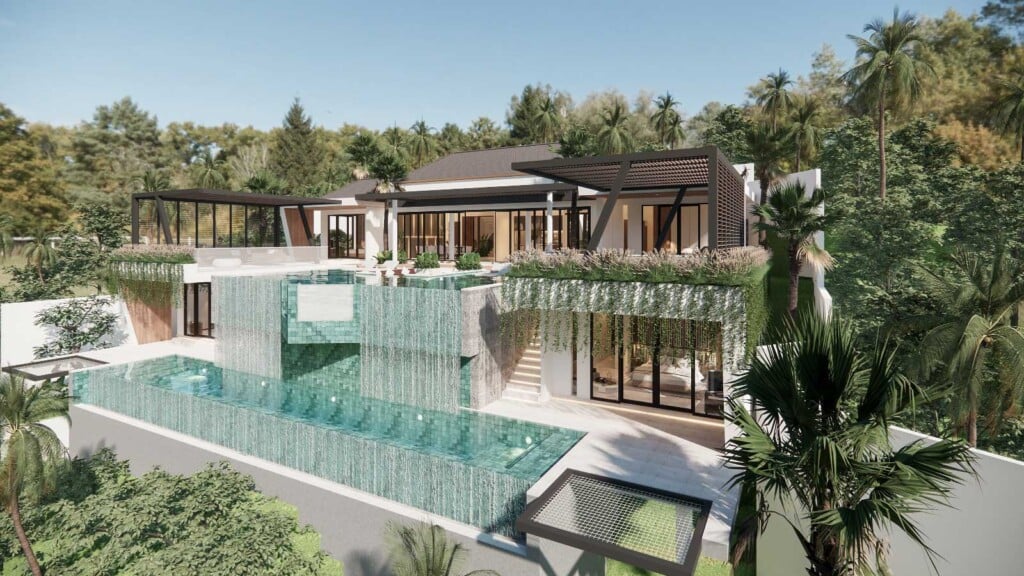The Sacred Monkey Forest Sanctuary, or Mandala Suci Wenara Wana, is one of Ubud’s most iconic and must-visit destinations. Nestled in the heart of Bali’s cultural capital, this lush jungle sanctuary is more than just a tourist attraction—it’s a spiritual, ecological, and cultural gem that captivates visitors from around the globe.
In this 2025 guide, we’ll uncover everything you need to know about the Sacred Monkey Forest, including tips for visiting, fascinating facts, and why this enchanting area also appeals to those looking to invest in Ubud’s serene villas.
What is the Sacred Monkey Forest Sanctuary?
The Sacred Monkey Forest is a natural reserve and temple complex spanning approximately 12.5 hectares. Located in Padangtegal, Ubud, the sanctuary is home to over 1,000 long-tailed macaques (Macaca fascicularis) that roam freely in the area. These playful creatures are revered by the locals, symbolizing harmony between humans and nature.
Beyond its playful inhabitants, the sanctuary houses three ancient temples dating back to the 14th century:
- Pura Dalem Agung: The Main Temple, dedicated to Lord Shiva.
- Pura Beji: A temple used for purification rituals.
- Pura Prajapati: A funeral temple near the cremation grounds.
Unique and Fascinating Facts About the Monkey Forest
- Sacred Forest Status: The forest is considered holy by the local community. Its preservation is closely tied to traditional Balinese Hinduism.
- A Natural Oxygen Hub: The sanctuary’s dense jungle acts as a vital green lung for Ubud, contributing to cleaner air in the area.
- Monkey “Kingdoms”: The macaques live in groups with their own territories within the sanctuary. Territorial disputes can often be witnessed during your visit.
- Rare Flora: The forest is home to over 186 species of trees, some of which are used in traditional Balinese rituals.
- Sustainable Tourism: Entrance fees are reinvested into maintaining the sanctuary, supporting both the environment and the local community.
How To Get There
The Sacred Monkey Forest is located in Padangtegal village, right in the heart of Ubud, making it easily accessible for those staying in the area. From Ubud Palace, it’s just a 15–20 minute walk south via Jalan Monkey Forest, a route that offers a charming glimpse of Ubud’s vibrant streets lined with artisan shops and cafes.
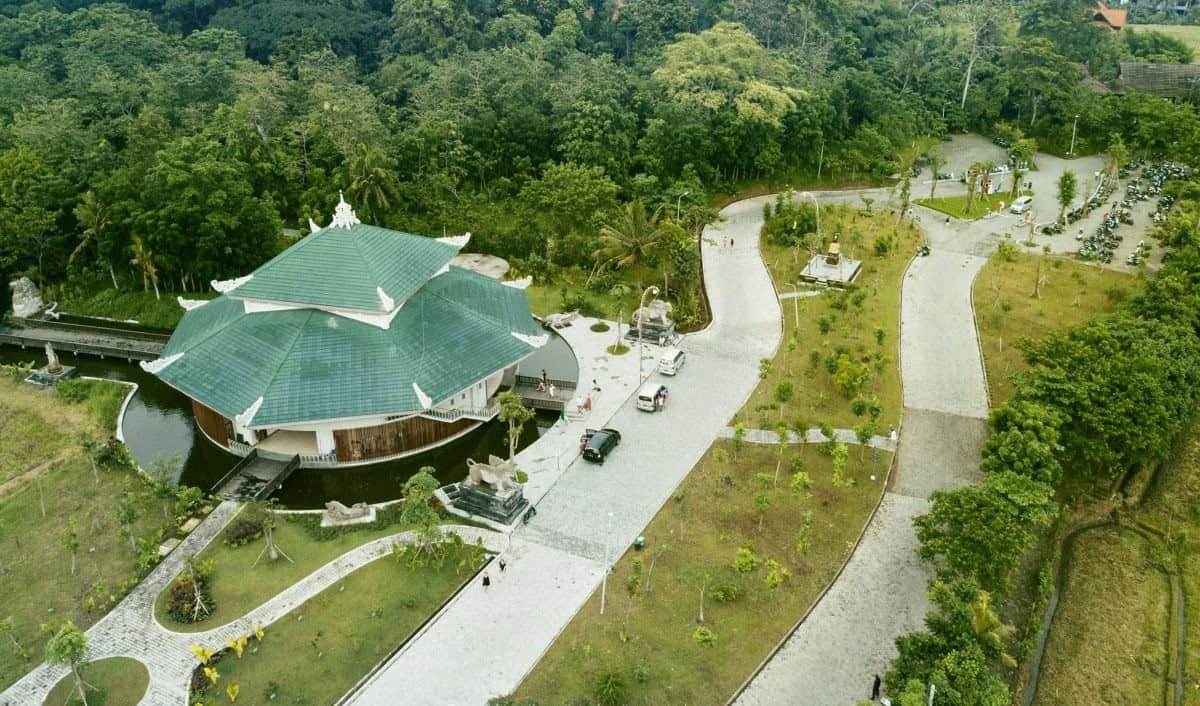
Cycling is another excellent option, allowing you to explore the scenic surroundings while avoiding traffic. Alternatively, you can rent a scooter, which costs around IDR 60,000–80,000 per day and provides a convenient way to navigate Ubud, with parking available near the sanctuary. For a more effortless option, ride-hailing apps like GoJek or Grab offer quick rides to the Monkey Forest, typically costing between IDR 30,000–50,000.
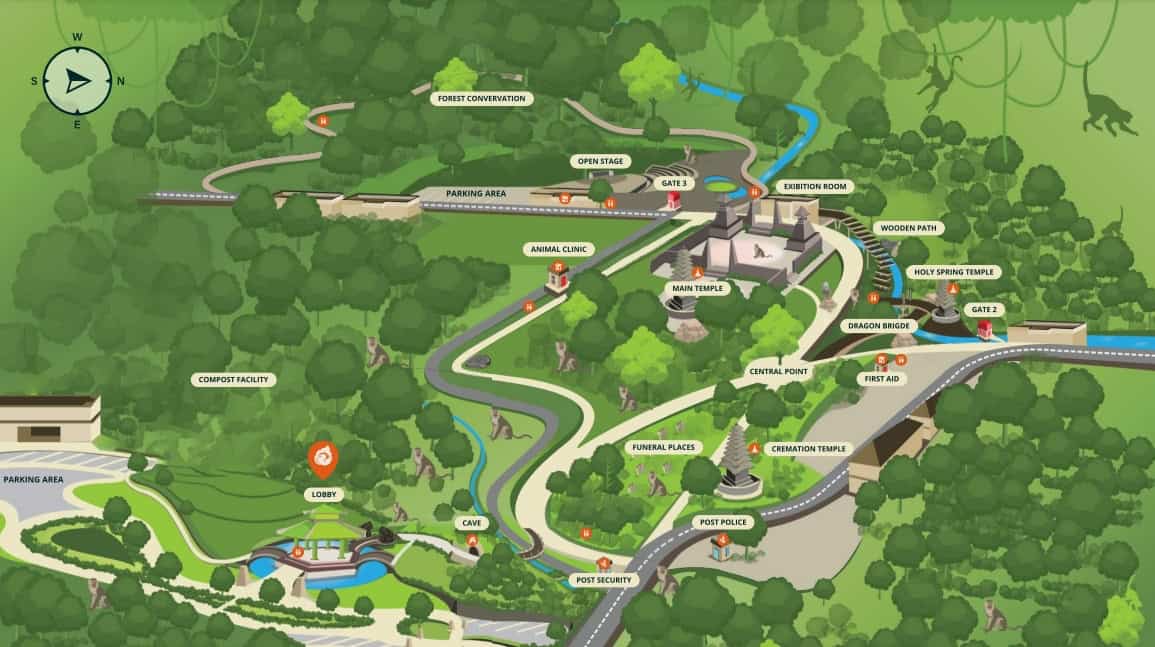
If you are staying outside Ubud, such as in Seminyak or Canggu, the best way to reach the Sacred Monkey Forest is by hiring a tour guide or renting a scooter for the day. For those traveling from Bali’s Ngurah Rai International Airport in Denpasar, the Monkey Forest is approximately 37 kilometers (23 miles) away, with a journey time of 1.5–2 hours depending on traffic. A private car transfer or renting a scooter is the most comfortable and efficient option for this longer trip.
Entrance Fee
The ticket prices are subject to annual increases due to the sanctuary’s popularity as a top tourist destination in Bali.
- Adults (Weekdays): IDR 100,000 (~$5 USD)
- Adults (Weekends): IDR 120,000
- KITAS/KITAP Holders: IDR 60,000
- Kids (Ages 3–12, Weekdays): IDR 80,000
- Kids (Ages 3–12, Weekends): IDR 10,000
- Kids (Ages 0–3): Free
Also, visitors can capture unforgettable moments with the sanctuary’s playful macaques. The staff is available to help you take photos, including popular “monkey selfies,” for an additional fee of IDR 50,000.
Things to do in Monkey Forest Ubud
Here’s a closer look at the three main attractions that make the Monkey Forest a must-visit spot in Bali.
Monkeys
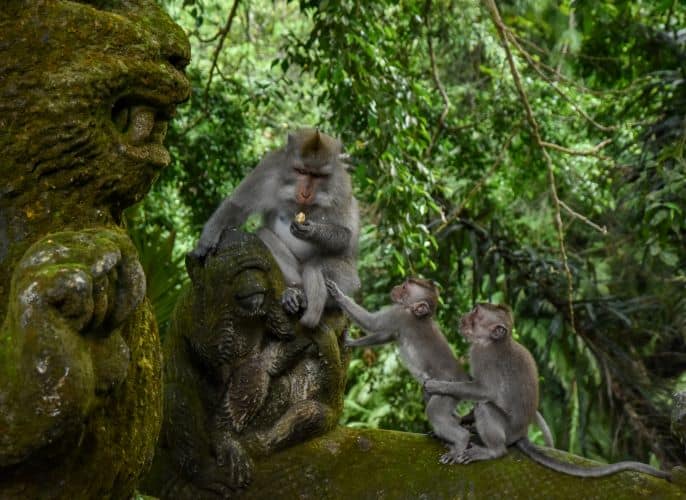
The Sacred Monkey Forest Sanctuary is home to over 1,000 long-tailed macaques (Macaca fascicularis), living in their natural habitat. These playful creatures are divided into several groups, each with its own territory within the forest. One unique fact about the monkeys is their fascinating social behavior—they groom each other not only for hygiene but also as a way to strengthen bonds and show respect within their group.
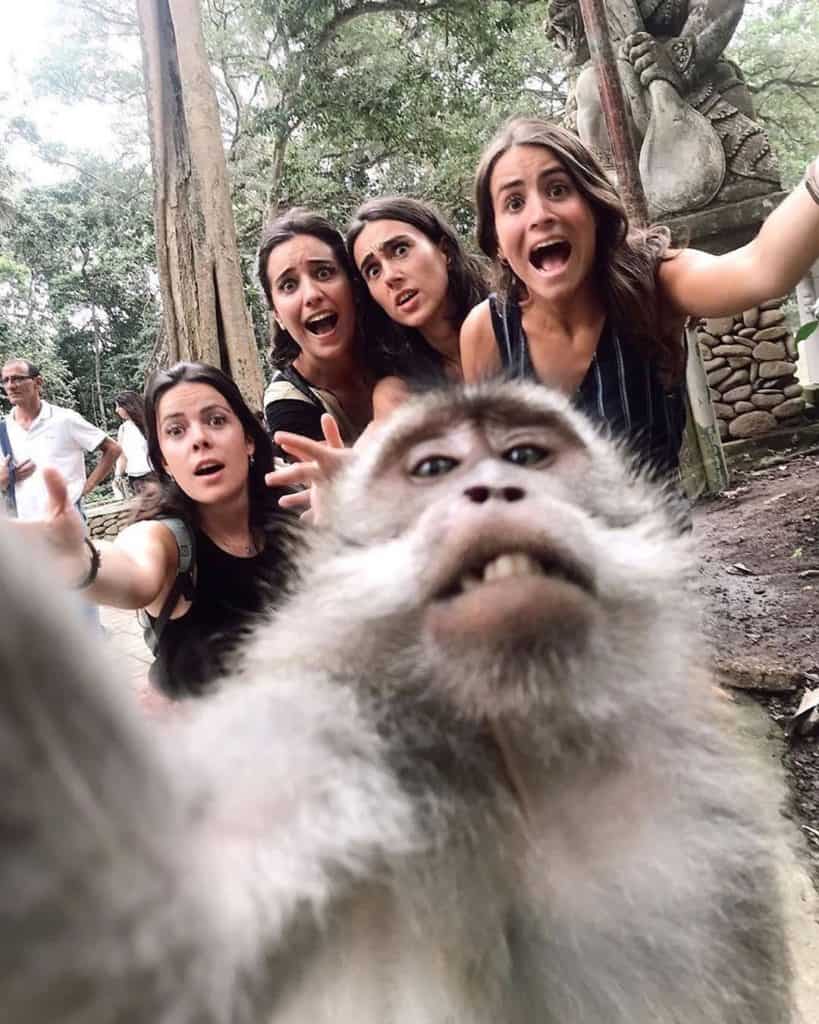
Beyond observing their antics, you can also contribute to their well-being. A donation to Monkey Forest Ubud directly supports efforts to preserve this sanctuary. Your contribution helps provide nutritious food, veterinary care, and enrichment activities for the monkeys, while also maintaining their lush habitat. It’s a meaningful way to help sustain this iconic destination and promote conservation efforts that benefit both the wildlife and cultural heritage of the area.
Culture
As part of the cultural attractions at the Monkey Forest, you can enjoy traditional Balinese performances like the Frog Dance (Tari Katak) and the Lubdaka Dance (Tari Lubdaka). The Frog Dance showcases playful, agile movements inspired by frogs, symbolizing themes of loyalty and perseverance.
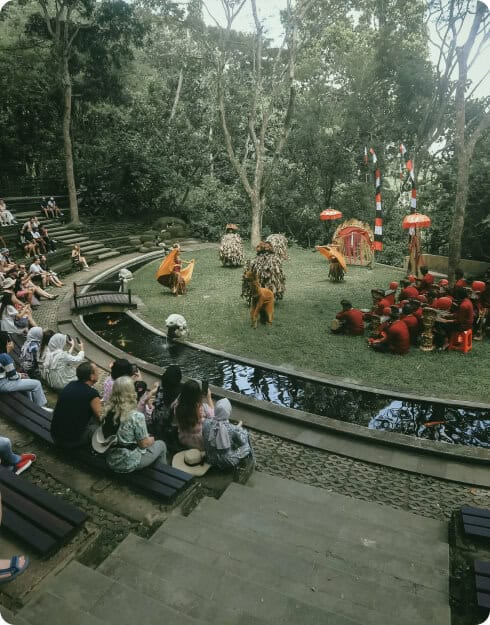
The Lubdaka Dance, originating from the Mahabharata epic, tells a poignant story of sacrifice and the triumph of good over evil through graceful choreography and vibrant costumes. These captivating performances offer you a deeper connection to Bali’s rich cultural heritage.
Tips: book and come on the weekend because the cultural attractions only perform on Saturday and Sunday at 11am and 4pm.
Sacred Place
When you visit the Sacred Monkey Forest Sanctuary, you’re not just stepping into a haven for playful macaques—you’re also entering a mystical world of ancient temples, statues, and lush jungle landscapes. The sacred atmosphere of this sanctuary is what truly sets it apart, offering you a glimpse into Bali’s spiritual and cultural heritage.
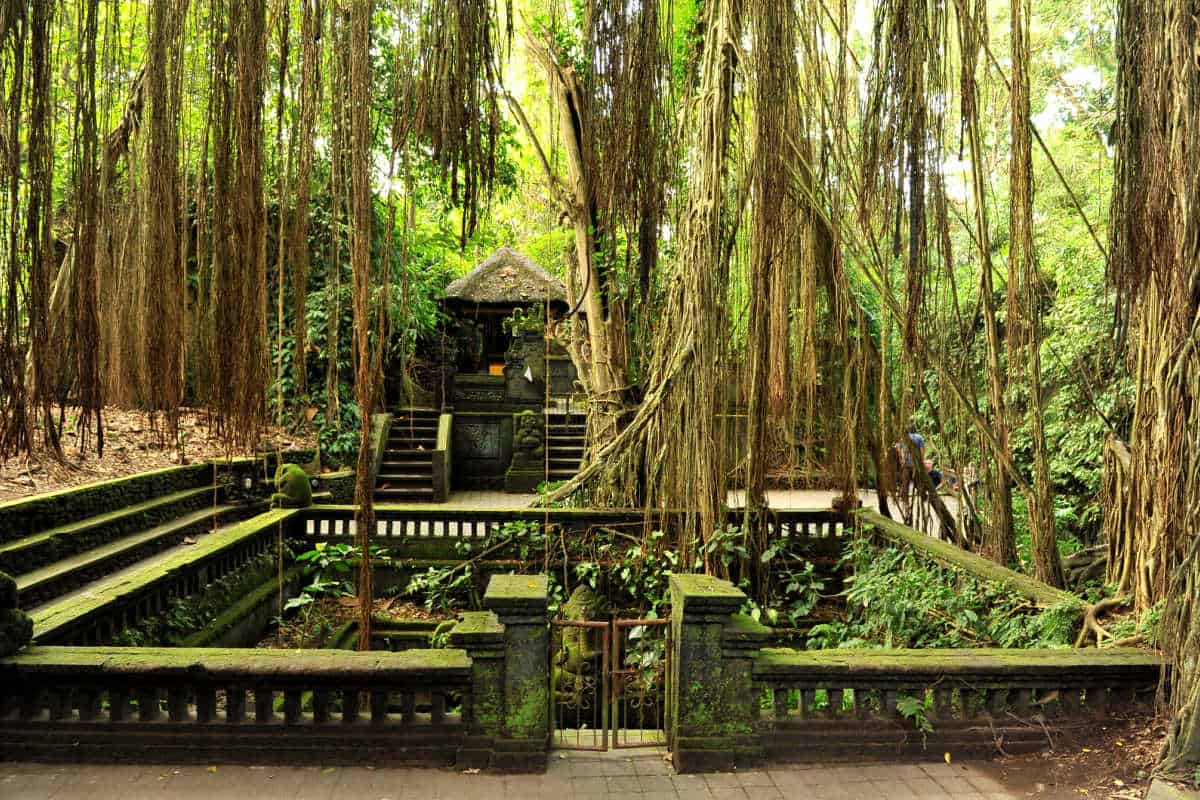
As you wander through the forest, you’ll find yourself surrounded by towering trees, some of which are believed to be centuries old. One of the most remarkable is the giant banyan tree, thought to be over 100 years old.
The Monkey Forest is home to three sacred Hindu temples, each steeped in history and spiritual significance. The main temple, Pura Dalem Agung Padangtegal, is believed to date back to 1350 AD, making it one of the oldest in the region. Tourists aren’t allowed to enter these sacred sites but you can take stunning photos right from the temple gates.
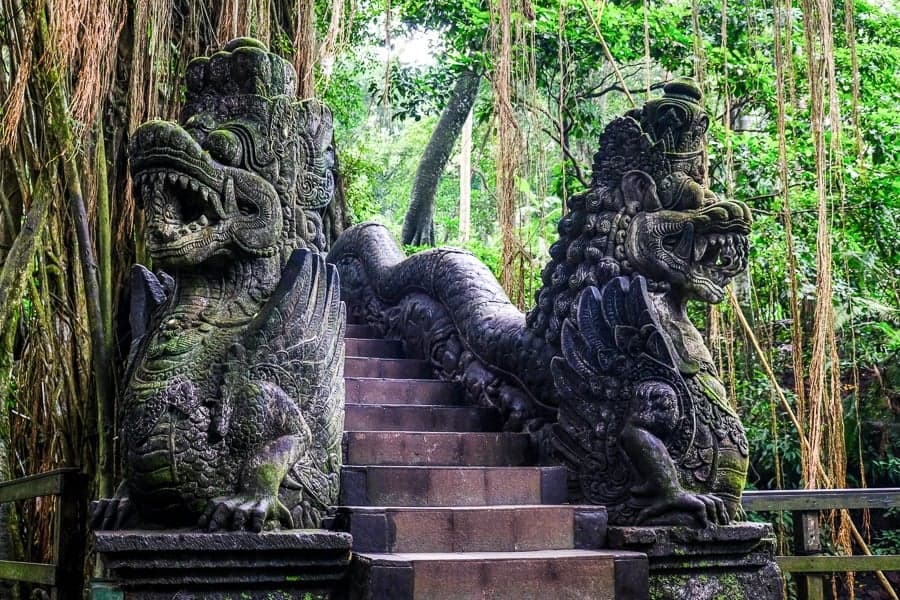
One thing to not miss is the stone bridge that stretches across a lush ravine. Guarded by two majestic dragon statues, this bridge offers a perfect blend of natural beauty and ancient artistry. It’s a favorite spot for visitors to capture the magic of the Monkey Forest.
Things NOT TO DO in Monkey Forest
There are a few important rules to follow to ensure your safety and protect the monkeys. Here’s a list of things you should NOT do while you’re there:
- Don’t Wear Valuables: Monkeys might steal earrings, necklaces, or shiny accessories.
- Don’t Wear Glasses or Sunglasses: They could grab them off your face.
- Don’t Bring Food or Snacks: Monkeys can smell it and may become aggressive.
- Don’t Feed the Monkeys: Outside food can harm their health.
- Don’t Carry Plastic or Paper Bags: Monkeys associate these with food and will grab them.
- Don’t Panic or Run: Stay calm to avoid provoking them.
- Don’t Make Eye Contact or Smile: They see it as a threat or challenge.
- Don’t Touch the Monkeys: Let them approach you if they want, but don’t grab them.
- Don’t Leave Kids Unattended: Always supervise your children, especially around older monkeys, as they can be larger (up to 10 kilos/22 pounds) and more aggressive.
- Don’t Overreact to Monkey Antics: They might climb on you or grab something out of curiosity. Stay calm, and they’ll move on.
One of Reasons to Invest
The Sacred Monkey Forest Sanctuary has been a cornerstone of Ubud’s tourism for decades, consistently drawing visitors from around the world. Its enduring popularity, combined with an increasing number of tourists each year, highlights the area’s continued appeal as a travel destination.
As one of Ubud’s main attractions, the Monkey Forest ensures a steady flow of visitors, making it an ideal location for real estate investment. Properties in Ubud benefit from both the cultural vibrancy of the area and its proximity to iconic landmarks like the Monkey Forest.
If you’re considering investing in Bali’s real estate market, especially in Ubud, the enduring allure of the Monkey Forest is a compelling reason to act now. It’s a prime opportunity to capitalize on the region’s thriving tourism and growing demand for accommodations and long-term stays.
You’ll need 1 to 2 hours to explore the Sacred Monkey Forest Sanctuary at a relaxed pace. If you’re planning to watch a weekend dance performance or simply soak in the serene atmosphere, you may want to extend your visit to 3 hours.
When visiting the Sacred Monkey Forest, it’s best to wear comfortable and modest clothing suitable for walking and the tropical climate.
As of January 1, 2025, the public bus service TemanBus, which previously operated in Ubud, has ceased operations. Unfortunately, there are currently no public transportation options directly available to reach the Monkey Forest.
Yes, it’s safe if you follow the rules. Avoid touching or feeding the monkeys, keep valuables secure, and stay calm if they approach you.
The monkeys are monitored, and cases of rabies in the sanctuary are extremely rare. However, avoid contact to minimize risk and ensure your tetanus and rabies vaccinations are up-to-date before visiting.

